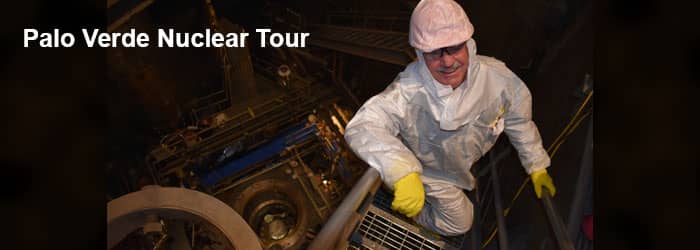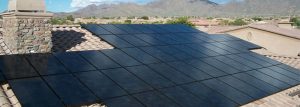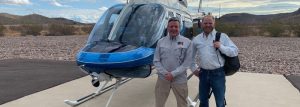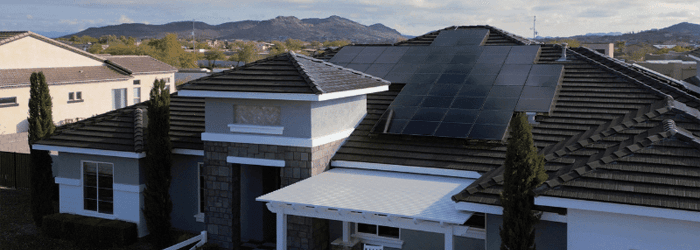Palo Verde Nuclear Generating Station is the energy cornerstone of the southwest. We were lucky enough to be able to send Rosie, Romey, and our Office Manager Jen G. on a tour of the facility, the reactor containment buildings, as well as the training room for the control center. There was so much to see and learn throughout the whole tour, it would take weeks to share it all, so we boiled it down to a few takeaways.
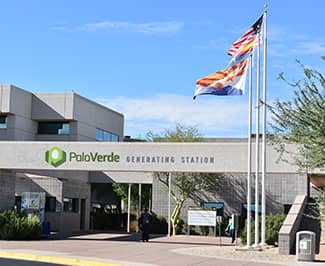
1 | Who Owns Palo Verde Nuclear Power Plant?
One of the things we weren’t expecting to learn about Palo Verde Nuclear Power Plant is the fact that it is actually owned by a total of 7 different companies: Arizona Public Service (APS), Salt River Project (SRP), El Paso Electric Co., Southern California Edison, PNM Resources, Southern California Public Power Authority, Los Angeles Department of Water & Power.
APS is the company with the contract to operate the facility and also the majority owner at 29.1% followed by SRP owning 17.5%.
Palo Verde provides power that stretches across four states; Arizona, California, New Mexico, and Texas; which is enough power to supply about 4 million people.
2 | What Percent of Our Power Comes from Nuclear?
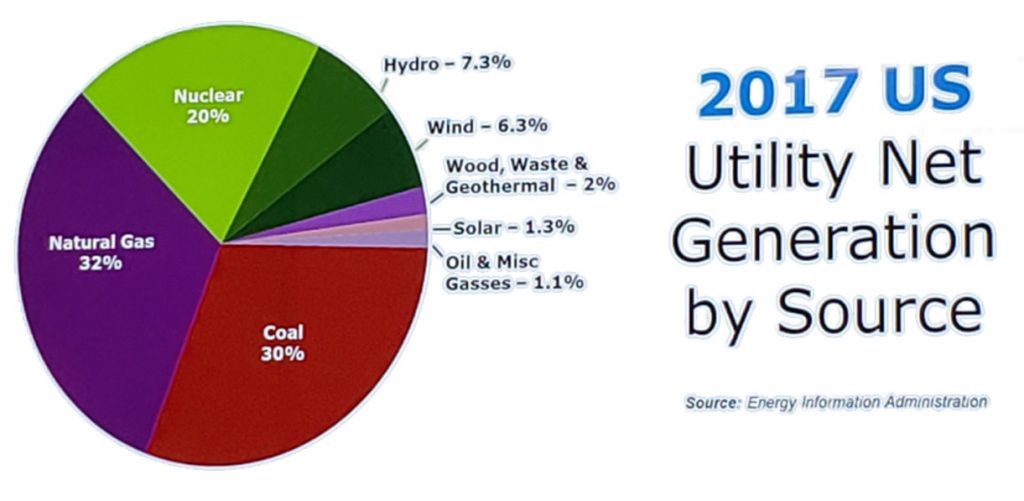
Surprisingly enough, as of 2017, nuclear only covers about 20% of our Net Utility Generation. The rest is made up of 32% natural gas, 30% coal, 7.3% hydro, 6.3% wind, 2% wood, waste & geothermal, 1.3% solar, and 1.1 % oil & miscellaneous gasses.
Nuclear is a relatively clean energy and relies on coal and gas to provide power to its plant in order to operate its facility. Each person for a 75-year lifetime will only use as much nuclear waste to fill a soda can.
In comparison, you would need more than 26,000 football fields full of solar panels to generate the same amount of electricity as Palo Verde Generating Station annually. That’s 54 square miles which covers the entire city of Avondale and then some. (Avondale is 45 square miles).
How did we get to that?
According to the EPA in their article Green Power Equivalency Calculator – Calculations and References, they conclude that one football field filled with solar PV would generate 1,287,336 kWh annually. (See section titled Number of Football Fields of Solar Powered for One Year.) In comparison, Palo Verde creates 33,848,640,000 kWh annually.
So, how many football fields of solar equal Palo Verde’s production? Approximately 26,294 football fields or about 54 square miles.
3 | Water’s Role and Where It Comes From
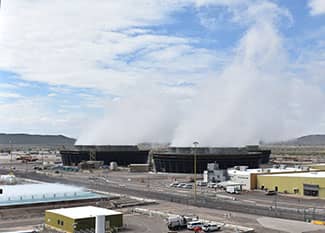
A lot of people don’t realize on a day to day basis that they live so close to the largest nuclear power plant in the United States. The other thing that doesn’t cross minds often is the fact that Palo Verde is the only nuclear generating facility in the world that is not located adjacent to a large body of above-ground water.
One of the many unique factors is the way the facility obtains its water. It is piped 36 miles from the Phoenix Reclamation Plant. At the nuclear plant site, the wastewater is further treated and stored in an 80-acre reservoir for use in the plant’s cooling towers. This water is also used to create the steam that spins the turbines, thus creating electricity to the tune of 1.9 million horsepower and 32 million megawatt hours.
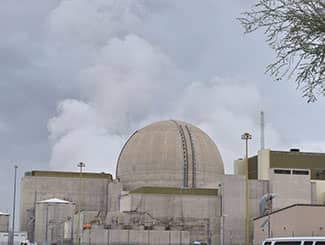
4 | Reactor Containment Buildings
One of the things we noticed was that there seemed to be plenty of space for personnel. Unlike most multi-unit nuclear power plants, each unit at Palo Verde is an independent power plant, sharing only a few minor systems between them. The reactor containment buildings are some of the largest in the world at about 2.6 million cubic feet enclosed. The three containment domes over the reactors are made of 4-foot thick concrete.
It was amazing being able to tour through the reactor containment buildings. We got the chance to tour Reactor #3 which was down for refueling at the time. Every 6 months, Palo Verde shuts down one of its three reactors so that the uranium fuel rods can be taken out, placed in a cooling pool, and then replaced with fresh rods for another run. The reactors are refueled in the spring and fall to ensure they are operating during the summer, which is when the seven utilities from Texas, New Mexico, Arizona, and California rely on Palo Verde electricity the most.
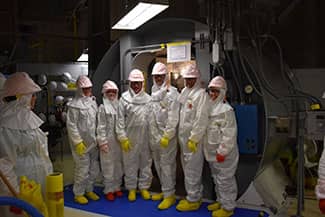
There were so many safety precautions to take every step of the way that helped prevent us from exposure and other random incidents (which never occurred). Throughout the whole tour we were required to wear eye protection and hardhats. Before we were allowed to go into contamination, we had to sit through a safety briefing. At the end of the briefing, we were all handed personal radiation monitors and white coveralls to put over what we were already wearing. There was a large body suit we had to zip into which had a special pocket for our radiation monitors, booties for our feet, gloves for our hands, masks that completely covered our heads, minus our faces, and on top of that we still had our hardhats on which received a coverall of its own!
5 | When is most of the power consumed and how is it protected?
Most nuclear power is used in the evenings when the sun goes down and everybody is coming home from work. The amount of solar energy that is given to the electrical grid during the day is much higher when the sun is at its peak. Once solar stops producing as much power, nuclear kicks in and takes care of the rest. If we wanted to sustain our power grid without nuclear, we would need solar fields that would take the land mass of about PHX and Scottsdale combined.
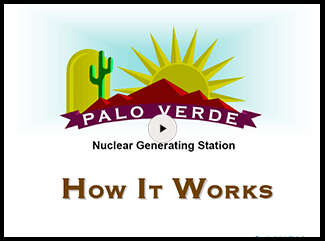
Being such an important source of energy, there are a number of backups in place to insure a smooth operation. Some job positions at the Palo Verde Generating Station require that you live in a 10-mile radius of the generating station. Should they be needed, these key employees are close enough to get there in a timely manner. If anything happens at Palo Verde and critical steps are not taken as required, the nuclear part of the plant is designed to shut itself down within 15 minutes and huge diesel generator will start-up and take over. As mentioned above, the 80-acre reservoir is also one of the backups. Should there be a break in the water pipeline, Palo Verde has enough water to last weeks in order to maintain proper operation until the pipeline is returned to fully working order.
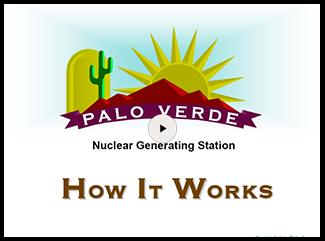
We would love to give a big thank you to all that were involved in the tour. Everybody was very helpful and knowledgeable along the way.
Briefers and presenters throughout the day:
- Bob Bement, Executive Vice President and Chief Nuclear Officer
- Jack Cadogan, Senior Vice President, Palo Verde Site Operations
- Mike McLaughlin, Vice President, Palo Verde Operations Support
Tour Guides:
- Christy Arter, Industry Relations Evaluator
- Rick Lange, Assistant Plant Manager, Palo Verde Water Reclamation Facility
- Don Naughton, Director, Strategic Business Services
Tour Facilitators:
- Jill Hanks, APS Media Relations
- Kory Raftery, Palo Verde Communications
- Greg Cameron, Palo Verde Communications
and security personnel who escorted us around the plant but will remain un-named in accordance with security protocol. We had a wonderful experience and look forward to a second tour once we’ve had time to digest all the information from the first tour!
To lean more about Palo Verde Nuclear Generating Station, check out the full presentation here. Please note some of the information presented may be dated. Originally published 11-03-2018. Updated 07-16-2021.
GO BACK AND LISTEN TO THE PODCAST!
###
Photo Credits:
- Rosie on the House | Jen Gura
- APS / Palo Verde

